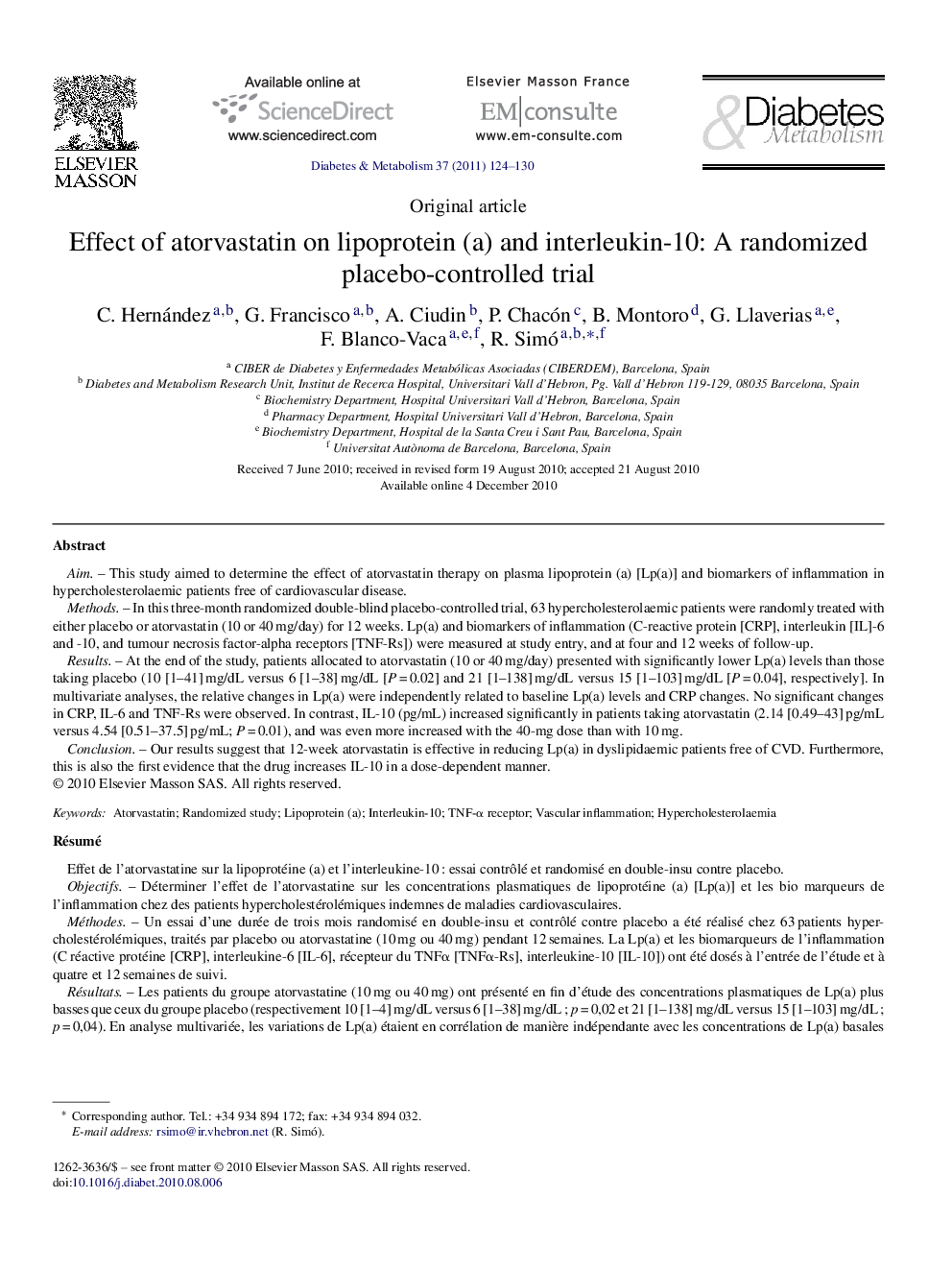| کد مقاله | کد نشریه | سال انتشار | مقاله انگلیسی | نسخه تمام متن |
|---|---|---|---|---|
| 3259896 | 1207594 | 2011 | 7 صفحه PDF | دانلود رایگان |

AimThis study aimed to determine the effect of atorvastatin therapy on plasma lipoprotein (a) [Lp(a)] and biomarkers of inflammation in hypercholesterolaemic patients free of cardiovascular disease.MethodsIn this three-month randomized double-blind placebo-controlled trial, 63 hypercholesterolaemic patients were randomly treated with either placebo or atorvastatin (10 or 40 mg/day) for 12 weeks. Lp(a) and biomarkers of inflammation (C-reactive protein [CRP], interleukin [IL]-6 and -10, and tumour necrosis factor-alpha receptors [TNF-Rs]) were measured at study entry, and at four and 12 weeks of follow-up.ResultsAt the end of the study, patients allocated to atorvastatin (10 or 40 mg/day) presented with significantly lower Lp(a) levels than those taking placebo (10 [1–41] mg/dL versus 6 [1–38] mg/dL [P = 0.02] and 21 [1–138] mg/dL versus 15 [1–103] mg/dL [P = 0.04], respectively]. In multivariate analyses, the relative changes in Lp(a) were independently related to baseline Lp(a) levels and CRP changes. No significant changes in CRP, IL-6 and TNF-Rs were observed. In contrast, IL-10 (pg/mL) increased significantly in patients taking atorvastatin (2.14 [0.49–43] pg/mL versus 4.54 [0.51–37.5] pg/mL; P = 0.01), and was even more increased with the 40-mg dose than with 10 mg.ConclusionOur results suggest that 12-week atorvastatin is effective in reducing Lp(a) in dyslipidaemic patients free of CVD. Furthermore, this is also the first evidence that the drug increases IL-10 in a dose-dependent manner.
RésuméObjectifsDéterminer l’effet de l’atorvastatine sur les concentrations plasmatiques de lipoprotéine (a) [Lp(a)] et les bio marqueurs de l’inflammation chez des patients hypercholestérolémiques indemnes de maladies cardiovasculaires.MéthodesUn essai d’une durée de trois mois randomisé en double-insu et contrôlé contre placebo a été réalisé chez 63 patients hypercholestérolémiques, traités par placebo ou atorvastatine (10 mg ou 40 mg) pendant 12 semaines. La Lp(a) et les biomarqueurs de l’inflammation (C réactive protéine [CRP], interleukine-6 [IL-6], récepteur du TNFα [TNFα-Rs], interleukine-10 [IL-10]) ont été dosés à l’entrée de l’étude et à quatre et 12 semaines de suivi.RésultatsLes patients du groupe atorvastatine (10 mg ou 40 mg) ont présenté en fin d’étude des concentrations plasmatiques de Lp(a) plus basses que ceux du groupe placebo (respectivement 10 [1–4] mg/dL versus 6 [1–38] mg/dL ; p = 0,02 et 21 [1–138] mg/dL versus 15 [1–103] mg/dL ; p = 0,04). En analyse multivariée, les variations de Lp(a) étaient en corrélation de manière indépendante avec les concentrations de Lp(a) basales et les variations de la CRP. Aucune modification significative de la CRP, de l’IL-6 et du TNF-Rs n’a été observée. En revanche, les concentrations d’IL-10 ont augmenté de manière significative chez les patients recevant l’atorvastatine (2,14 [0,49–43] pg/mL versus 4,54 [0,51–37,5] pg/mL ; p = 0,01), de manière plus importante avec 40 mg qu’avec 10 mg d’atorvastatine.ConclusionCes résultats suggèrent que l’administration d’atorvastatine pendant 12 semaines permet de réduire de manière efficace les concentrations plasmatiques de Lp(a) de patients hypercholestérolémiques indemnes de maladies cardiovasculaires. En outre, l’atorvastatine augmente l’IL-10 de manière dose-dépendante.
Journal: Diabetes & Metabolism - Volume 37, Issue 2, April 2011, Pages 124–130